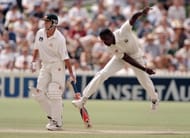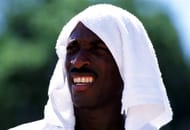From the bygone era of 1930s to early 90s, West Indies produced a slew of mighty fine fast bowlers who made batsmen quiver for cover with a mere stare. They seemed to have carnassial teeth and sharp claws of a lion to tear-apart any opposition into shreds. While growing up in the 90s, it even felt like they had a secret factory located in Barbados, where they produced one great fast bowler after another.
Now, who can forget reading about the likes of H.Griffith, Martindale, Constantine, Francis, (his peak period was around late 1920s) and company, giving the unsuspecting batsman a taste of chin-music in 1930s. Aficionados, remember how Constantine and Martindale tried to scare England’s captain, Jardine, with their own version of deadly bodyline fast bowling in 32/33. To Jardine’s credit, he didn’t flinch one bit by making a century.
The rich tradition of producing great fast bowlers continued after the World War 2, as the likes of Hall, C.Griffith, Gilchrist, Sobers, Holder, Roberts, Croft, Clark, Marshall, Holding, Garner, Winston Davis, Walsh, Bishop, Patterson and Ambrose raided and terrorised opposition ranks with pace, and disconcerting bounce for a period of almost five decades. The competition for a place in the side was such that fine fast bowlers like Mosley, Miton Small, Gray and few others, could play less than a handful of games.
In recent times though, West Indies have struggled to produce world class quick bowlers. Among those pacers who made their debut aftermath of that historic series defeat against Australia in 94/95, the only Windies bowler to take more than 100 wickets is Merv Dillon. As a cricket-obsessed fan who craved to watch those great spells of fast bowling by the fearsome troika of Bishop, Walsh and Ambrose in the early 90s, it saddens me to no end that not even a single world-class fast bowler has emerged form the land of Caribbean in the last two decades. For all those effervescent efforts of Dillon, he himself was nothing more than a workman-like pacer. Some quicks did show promise, but fell by the wayside quickly.
In this article, I would look at pacers from the land of Caribbean who in spite of showing early promise to make it into the top-echelon of fast bowlers in test cricket, faded away.
The Windward Islands’ towering giant, Cameron Cuffy, sent shock waves through India’s famed batting line-up in his first one-day series in India in 94/95. In the second one-day game of that series, he caught the eye by dismissing the little master, Tendulkar, with a brute of a back of a length delivery. Reams and acres of print were expended on him being a carbon copy of West Indies’s spearhead Ambrose. But from the start, it was clearly evident that he was not going to be a worthy successor of Ambrose. In spite of it, there was an inkling that he was going to serve West Indies’s cricket with distinction, in the years to come.
A variety of reasons, ranging from some wayward spells bowled by Cuffy, to not being able to get into the side due to the presence of established stars like Ambrose and Walsh meant that he soon found himself in the wilderness. Cuffy, did make a comeback into the team in a tri-series held in Australia in 00/01. But by then, he had lost a yard of pace, and was nothing more than a honest-trier. Interestingly, his last Test series was against the team that he made his debut – India.
The case of chunky Barbadian, Patterson Thompson, is an interesting one. His ambition was to become a fine pilot, but he suddenly discovered that he could bowl genuinely quick too. Very soon, he was playing in the Red Stripe cup in 94/95, and was drafted into the Windies set-up in 95/96 to play a test series against the Kiwis. Incidentally, he replaced, Cuffy, who had a disappointing World cup in the subcontinent in 95/96.
Just a few days before the test series against Kiwis, Thompson, with his barrel-chested-action captured the imagination of cricket loving public in the Caribbean by bowling a nasty bouncer to smash the Kiwi batsman, Astle, on his chin in a warm-up game. The deadly bouncer is said to have frightened Kiwis to death, as blood was splattered everywhere on the track. The downside to Thompson’s bowling though, was that he just couldn’t bowl with any control. Thompson was so wayward in his debut test that swashbuckling Kiwi batsman, Astle, took sweet revenge for being hit on the chin by carting him all over the park. In fact, Thompson bowled a whopping 22 no balls in that test, and ended-up with embarrassing match returns of 22 – 1 – 135 -4
The Wisden described him as, “When he made his Test debut for the West Indies against New Zealand in Barbados in 1995-96, Patterson Thompson had a shocker. Making Devon Malcolm look like a metronome, he bowled 22 no-balls and returned match figures of 22-1-135- 4 – which flattered him. He played just one more Test, in Australia the following winter, and that was that. His Test strike rate, 45.6, would do anyone proud but his economy rate, 5.65, would make even a joke bowler blush.”
Thompson tried to eradicate the no-ball problem by shortening his run-up in Australia in 96/97, but to no avail. He finally gave-up on cricket by 98/99, and nowadays, is a said to be a final commercial-pilot.
The Jamaican, Rose, caught the eye of Caribbean’s cricket cognoscenti when he ripped-open a strong Trinidad & Tobago’s batting line-up with a 5-for in Red Stripe cup in 92/93. Everyone in the Caribbean Islands rated him highly, but disciplinary issues meant that he made his Test debut only in 96/97 against India.
On an unusually placid surface at Jamaica against India in 96/97, the king of mass destruction, Ambrose, for once looked a touch lacklustre. But that day, Franklyn Rose, rose to the occasion with a 6 wicket haul. He wasn’t an out-an-out fast bowler yet. He had that uncanny ability to surprise the batsman with an extra burst of pace. He could also extract seam movement out of most surfaces. In a Test series against South Africa in 98/99, he showed that his 5-for against India wasn’t a flash in the pan by taking 7 for 84. Just when it looked like West Indies had found an attack leader, Rose, was dogged by disciplinary issues yet again. In his final Test series in England in 2000, he looked a pale shadow of his former self.
In ’97, Nixon McLean, emerged from the stables of West Indies’s fast bowling tribe with great hope. When England toured the Caribbean in 97/98, all the talk in cricketing circles centred around whether McLean was the right man to take the torch of fast bowling from old warhorses like Ambrose, Walsh and Bishop. He couldn’t bowl in his debut Test at Jamaica, as the game was infamously abandoned after a few overs were bowled due to the track being too treacherous for batting. In subsequent Test matches he played in that series, he didn’t take too many wickets, but impressed one-and-all with his raw pace.
The downward trend in his cricketing graph started in South Africa in 98/99 when for some unknown reason, he decided to bang it half way down the pitch for most of the Test series. The South African batsmen, well-known for being very good square of the wicket on either side, made a mincemeat of his bowling. At the dawn of the new century in 2000, McLean did make a comeback by bowling a few incisive spells in England as well as in Australia. But he soon disappeared into oblivion.
In the second part of the article, I will look at a few more pacers who fell by the wayside. Also, a sneak peek at the current crop of Windies quicks.
For part 2, click here.
Brand-new app in a brand-new avatar! Download CricRocket for fast cricket scores, rocket flicks, super notifications and much more! 🚀☄️


